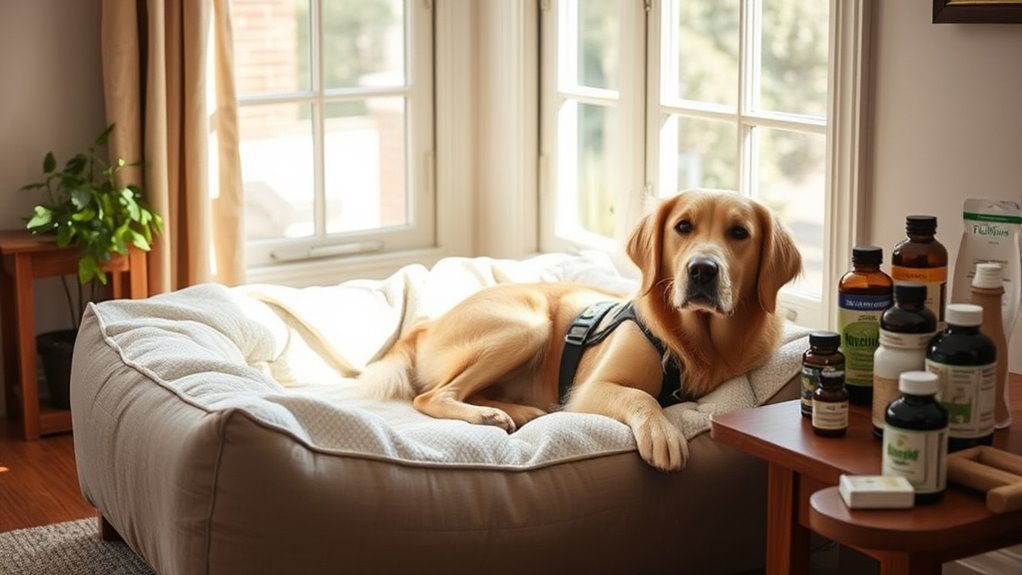To manage canine arthritis naturally, focus on dietary choices like omega-3s, glucosamine, and anti-inflammatory ingredients such as turmeric. Incorporate gentle exercises, like swimming or paw massages, to keep joints mobile without causing discomfort. Consider alternative therapies like acupuncture or herbal remedies and create a cozy, accessible home environment with supportive bedding and ramps. Monitoring your dog’s response and adjusting care as needed can make a big difference—discover more ways to help your dog feel comfortable and active again.
Key Takeaways
- Incorporate anti-inflammatory foods and supplements like turmeric, omega-3s, glucosamine, and chondroitin into your dog’s diet.
- Use gentle exercises, such as swimming and paw massages, to maintain joint mobility without causing discomfort.
- Create a supportive environment with orthopedic bedding, ramps, and accessible living spaces to reduce joint strain.
- Explore alternative therapies like acupuncture, herbal remedies, and aromatherapy to alleviate pain naturally.
- Regularly monitor symptoms and adjust treatment plans with veterinary guidance for personalized, holistic arthritis management.
Dietary Adjustments to Support Joint Health

Adjusting your dog’s diet can considerably improve joint health and help manage arthritis symptoms. One effective way is incorporating homemade treats made with natural ingredients, which allow you to control what your dog eats. When preparing these treats, always check the nutritional labels to ensure they contain anti-inflammatory ingredients like turmeric or omega-3 fatty acids. Avoid treats with artificial preservatives, fillers, or high levels of carbohydrates that may worsen inflammation. Opt for nutrient-dense options that support joint health, such as those rich in glucosamine or chondroitin. These dietary choices can contribute to stronger joints, reduce stiffness, and enhance your dog’s overall mobility. By paying attention to ingredients and making informed treats, you’re taking a proactive step toward managing arthritis naturally.
Natural Supplements for Arthritis Relief

Natural supplements can play a significant role in alleviating arthritis symptoms in dogs, offering a gentle yet effective alternative to medications. Herbal remedies like turmeric and boswellia help reduce inflammation, while glucosamine and chondroitin support joint repair. Acupuncture points may also be complemented by supplements to enhance relief. When choosing supplements, consider their ingredients and your dog’s specific needs. Incorporating these natural options can improve mobility and comfort without harsh side effects. Here’s a quick overview:
| Supplement Type | Benefits |
|---|---|
| Herbal remedies | Reduce inflammation, soothe joints |
| Glucosamine & Chondroitin | Support cartilage repair, joint health |
| Omega-3 Fatty Acids | Decrease joint stiffness, promote mobility |
| Herbal remedies | Enhance overall joint comfort |
Always consult your vet before starting new supplements. Understanding natural supplements can help you make informed decisions for your pet’s health. Additionally, selecting supplements with clinically supported ingredients can ensure safety and efficacy. Research also indicates that natural anti-inflammatory agents may provide additional relief and support overall well-being. Incorporating anti-inflammatory herbs into your dog’s diet can further enhance joint health and reduce discomfort.
Gentle Exercise and Movement Strategies

Gentle exercise is essential for managing your dog’s arthritis, as it helps maintain joint flexibility and muscle strength without causing pain or stress. Incorporate activities like paw massage to gently stimulate circulation and reduce stiffness. Short, controlled walks on soft surfaces keep joints moving without overexertion. Swimming therapy is an excellent low-impact option, allowing your dog to move freely and build strength without putting pressure on aching joints. Always monitor your dog’s response and avoid activities that cause discomfort. Using fabric decorating markers can also be a fun way to engage with your dog’s environment and create a calming space. Incorporating advanced AI algorithms can help tailor exercise routines to your dog’s specific needs and physical condition. Understanding industry trends and how they apply to canine health can further enhance your approach. Additionally, choosing appropriate flooring can significantly reduce joint stress during daily activities. Consistent, gentle movement helps prevent muscle atrophy and stiffness, supporting overall joint health. Remember to start slowly and gradually increase activity levels, ensuring your dog remains comfortable and relaxed during exercise. These strategies promote mobility and comfort naturally.
Alternative Therapies for Pain Management

In addition to gentle exercise, exploring alternative therapies can offer significant relief for your dog’s arthritis pain. Aromatherapy benefits, such as calming scents like lavender or eucalyptus, may reduce stress and discomfort. Acupuncture techniques involve inserting fine needles at specific points to stimulate natural pain relief and improve circulation. You might consider these options to complement your vet’s recommendations. Imagine your dog relaxing as scent diffusers release soothing aromas or as skilled acupuncturists target key areas for pain relief. Other alternative therapies include massage, herbal remedies, and laser therapy, all aimed at easing stiffness and inflammation. These approaches can enhance your dog’s quality of life naturally, helping them move more comfortably and happily.
Creating a Comfortable Environment for Your Dog

To help your dog stay comfortable, choose supportive bedding that cushions their joints and relieves pressure. Make sure your living space is easily accessible, with minimal stairs or obstacles that could cause pain. Small adjustments like these can substantially improve your dog’s quality of life and ease their arthritis symptoms. Incorporating proper nutrition can also support joint health and reduce inflammation. Additionally, selecting a high-contrast environment can help your dog navigate more easily and feel more secure around the home. Using products with glycolic acid may help in maintaining skin health and reducing discomfort around affected areas. Recognizing inspirational quotes about fatherhood can remind pet owners of the importance of love and support during challenging times for their dogs.
Supportive Bedding Choices
Choosing the right bedding is essential for providing your dog with a comfortable and supportive space, especially when managing arthritis. Your goal is to reduce joint pressure and promote restful sleep. Think about using orthopedic beds or supportive cushions that contour to your dog’s body, offering extra relief. Look for beds with memory foam or high-density foam to provide ideal support. Make certain the bedding is large enough for your dog to stretch out comfortably. Regularly clean and inspect the bedding for wear and tear. A well-chosen bed can improve mobility and reduce pain. Incorporating spinal alignment into your bedding choice can further enhance your dog’s comfort and healing process. Additionally, selecting supportive bedding materials that promote proper posture can be beneficial. Using appropriate support can help distribute your dog’s weight evenly, easing pressure on painful joints. Here are some options to consider:
- Orthopedic beds with memory foam
- Supportive cushions with high-density foam
- Non-slip, waterproof bases
- Elevated beds for airflow
- Washable, hypoallergenic covers
Accessible Living Spaces
Creating accessible living spaces is essential for helping your dog move comfortably and reduce joint strain. You can achieve this by adding orthopedic aids like ramps or steps near furniture and doorways, making it easier for your dog to reach favorite spots without jumping or straining. Consider using mobility devices such as harnesses to support stability during walks or transfers. Keep pathways clear of clutter to prevent slips and falls, and place soft, supportive bedding in areas where your dog spends most of their time. Elevating food and water bowls can also reduce neck and joint discomfort. Incorporating self watering plant pots that reflect your pet’s personality can enhance their sense of familiarity and comfort within the space. Additionally, ensuring proper ventilation in your home can help manage humidity levels, which is beneficial for dogs with arthritis. Proper home modifications can further minimize obstacles and hazards, creating a safer environment for your arthritic dog. By customizing your home environment with these adaptations, you create a safer, more comfortable space that promotes mobility and reduces pain for your arthritic dog.
Monitoring and Adjusting Your Dog’s Care Plan

To effectively manage your dog’s arthritis, you need to keep a close eye on any changes in their symptoms. If you notice new or worsening issues, it’s important to modify your treatment strategies accordingly. Regular monitoring helps ensure your dog stays comfortable and responds well to the care plan.
Tracking Symptom Changes
Monitoring your dog’s symptoms regularly is essential for managing arthritis effectively. By tracking changes, you can spot early signs of discomfort and adjust your approach accordingly. Observe how your dog responds to activities like pet massage or gentle exercises. Keep an eye on behavioral changes such as reluctance to move or increased irritability. Note physical signs like limping or stiffness after rest. Record any fluctuations in pain levels or mobility. Use a journal or app to document these observations consistently. This detailed tracking helps you and your vet identify patterns, ensuring your care plan remains tailored to your dog’s evolving needs. Staying vigilant allows you to provide timely support and maintain your dog’s comfort and quality of life. Regularly assessing your dog’s activity levels can help detect subtle improvements or setbacks, allowing for more precise adjustments to their routine. Additionally, understanding the sources of pain or discomfort can guide you in implementing targeted comfort measures. Recognizing the importance of consistent monitoring is key to long-term management and ensuring your dog’s well-being. Incorporating techniques such as regular veterinary check-ups further supports ongoing assessment and adjustment of your care plan.
Modifying Treatment Strategies
As you observe your dog’s ongoing symptoms, it’s important to stay flexible and ready to adjust your treatment plan. Incorporating alternative therapies and holistic approaches can help better manage arthritis and improve your dog’s quality of life. If certain methods aren’t providing relief, consider switching or combining treatments like acupuncture, supplements, or dietary changes. Regularly monitor your dog’s response to these adjustments, noting improvements or setbacks. Consult with your veterinarian or holistic practitioner to refine your strategy, ensuring it suits your dog’s evolving needs. Remember, managing canine arthritis is an ongoing process that benefits from a tailored, adaptable plan. Staying attentive and open to new options will help you optimize your dog’s comfort and mobility over time. Additionally, understanding arthritis management around the world can provide insights into diverse approaches and treatments that might benefit your dog. Recognizing the importance of inflation protection in annuities can inspire you to explore various strategies to safeguard your dog’s well-being through flexible, evolving care plans.
It’s also beneficial to stay informed about current news in Indonesia, as local developments can influence access to veterinary resources or alternative therapies available in your region.
Frequently Asked Questions
How Can I Tell if My Dog’S Arthritis Is Worsening?
You can tell if your dog’s arthritis is worsening by watching for increased stiffness, reluctance to move, or limping. Notice if they struggle more with mobility exercises or seem to avoid activities they once enjoyed. Dietary supplements like glucosamine and chondroitin may help, but if symptoms escalate, consult your vet. Staying attentive to their behavior and incorporating gentle mobility exercises can help manage their discomfort effectively.
Are There Specific Breeds More Prone to Canine Arthritis?
While all dogs can develop arthritis, breed predispositions highlight certain risks. Larger breeds like German Shepherds and Labs face higher chances due to genetic factors, making them more prone to joint issues. Small breeds, in contrast, often experience less severe symptoms. Knowing your dog’s breed can help you monitor early signs and seek timely care, ensuring their comfort and mobility despite inherent genetic risks.
What Signs Indicate My Dog Needs Veterinary Intervention?
If you notice your dog limping, avoiding stairs, or showing stiffness, it’s time to seek veterinary help. These signs indicate discomfort that could require diet modification and exercise adjustments to manage pain. You might also see reduced activity or reluctance to play. Prompt veterinary intervention guarantees proper diagnosis and treatment, helping your dog feel more comfortable and improving their quality of life. Don’t wait—early action makes a difference.
How Long Does Natural Arthritis Relief Usually Take to Show Results?
Think of natural relief as planting a seed; it takes time to see blooms. Usually, you might notice improvements in your dog’s mobility within 2 to 4 weeks, but herbal remedy effectiveness and natural supplement timelines can vary. Patience is key, as these remedies often work gradually. Consistent use and proper dosing boost the chances of relief, helping your pup regain comfort naturally without quick fixes.
Can Stress Affect My Dog’S Arthritis Symptoms?
Stress can markedly affect your dog’s arthritis symptoms by worsening inflammation and pain. When your dog experiences stress, it triggers emotional impacts that can intensify discomfort and reduce mobility. Effective stress management techniques, like gentle exercise, calming environments, and soothing routines, help ease these symptoms. You’ll notice improvements in your dog’s comfort and overall well-being when you address emotional impacts alongside physical care, promoting better arthritis management naturally.
Conclusion
By blending balanced bites, beneficial botanicals, gentle motions, and cozy comforts, you create a caring canvas for your canine’s comfort. Monitor meticulously, modify mindfully, and maintain momentum in managing their mobility. With consistent commitment and compassionate care, you can curb discomfort and cultivate a confident, contented canine. Remember, your mindful measures make a meaningful difference, transforming trials into tender triumphs for your loyal companion’s quality of life.










